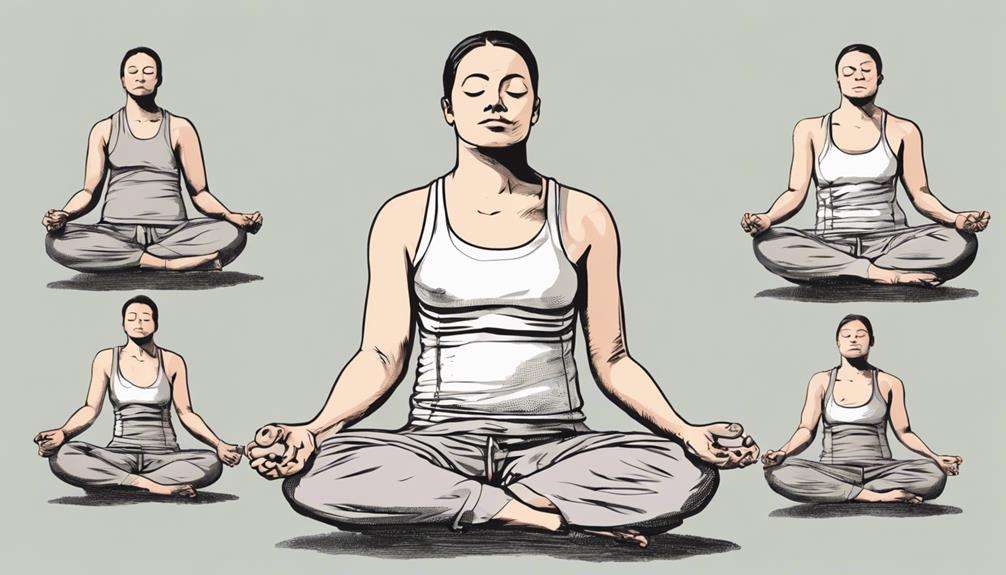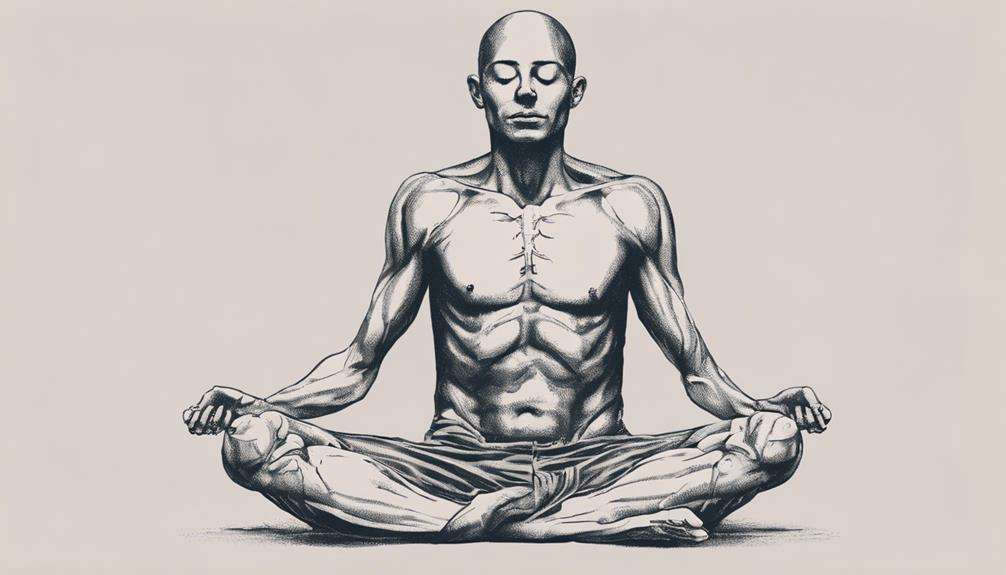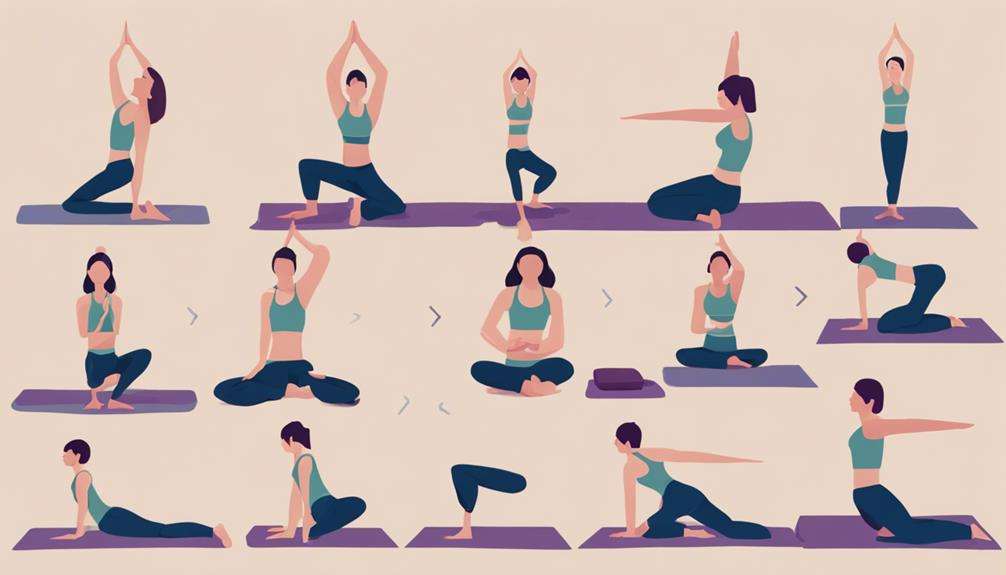Imagine a storm brewing inside you, causing chaos and unrest. Now, picture a gentle breeze sweeping through, gradually calming the turbulence within.
Deep breathing techniques serve as that soothing breeze, capable of restoring tranquility in the midst of life's storms. As you explore the power of intentional breathwork, you'll uncover a world where stress dissipates, and calmness prevails.
Discover how mastering these techniques can transform your daily experiences and elevate your well-being to new heights.
Key Takeaways
- Engage in belly breathing to enhance oxygen intake and relaxation
- Practice the 4-7-8 technique for calming the mind and reducing stress
- Start your day with morning breathing exercises for increased energy and clarity
- Prioritize deep nose-to-lower lung breathing for optimal stress relief and well-being
Belly Breathing Technique
To begin mastering the Belly Breathing Technique for stress relief, focus on inhaling deeply through your nose while allowing your belly to expand. This method, also known as abdominal breathing, engages the diaphragm to promote efficiently breathing and relaxation. Placing one hand on your belly and the other on your chest can help you monitor the movement of your breath. By emphasizing the expansion of your abdomen rather than your chest, you enhance the amount of oxygen entering your body, which is beneficial for your overall health.
Practicing belly breathing multiple times a day for about 10 minutes per session can significantly reduce stress and tension. This simple yet effective technique serves as a powerful tool to calm your mind and improve your well-being. By incorporating belly breathing into your daily routine, you can experience a sense of calmness and mental clarity that will positively impact your quality of life.
4-7-8 Breathing Method
Shifting focus from the Belly Breathing Technique, the 4-7-8 Breathing Method involves a specific breathing pattern that can greatly promote relaxation and reduce stress. This technique requires inhaling for 4 seconds, holding for 7 seconds, and exhaling for 8 seconds. By following this significant breathing rhythm, you can activate the body's relaxation response, leading to immediate stress relief and increased feelings of calmness. The 4-7-8 breathing method is known to calm the mind, slow the heart rate, and lower blood pressure effectively.
Breath control plays a significant role in managing stress levels and enhancing overall well-being. Incorporating the 4-7-8 breathing method into your daily routine can help you improve sleep quality, as it relaxes the nervous system and prepares the body for rest. This technique can be practiced multiple times a day, whenever you feel overwhelmed or in need of a moment of tranquility. Embrace the power of deep breathing techniques like the 4-7-8 method to cultivate a sense of calmness and promote relaxation in your daily life.
Morning Breathing Exercise

Upon waking, engage in the invigorating Morning Breathing Exercise to gently awaken your body and enhance your energy levels for the day ahead. This simple routine can set a positive tone for your day by promoting relaxation, increasing oxygen intake, and improving mental clarity.
Here's how to perform the Morning Breathing Exercise:
- Stand Up Straight: Start by standing with your feet shoulder-width apart to allow for proper airflow during the exercise.
- Inhale Deeply: Slowly bend forward while inhaling deeply through your nose, feeling the breath fill your lungs and expand your chest.
- Hold Briefly: Pause for a moment at the bottom of your breath to experience a sense of calm and stillness.
- Exhale Slowly: As you rise back up, exhale slowly through your mouth, releasing any tension or stress from your body.
Incorporating this Morning Breathing Exercise into your daily routine can help you start your day with a renewed sense of energy, calmness, and mental clarity.
Roll Breathing Practice
As you move forward from the invigorating Morning Breathing Exercise, the Roll Breathing Practice offers a deeper exploration into enhancing relaxation and expanding lung capacity through deliberate breathing techniques.
Roll breathing involves breathing deeply into the abdomen and ribcage, promoting diaphragmatic breathing that helps improve oxygen exchange and reduce stress levels. By focusing on controlled breathing, you engage in a rhythmic pattern that calms the mind and releases tension, ultimately leading to a state of deep relaxation.
This technique not only enhances breath control but also encourages chest breathing, which can be beneficial for overall well-being and mental clarity. Regular practice of roll breathing can significantly contribute to stress relief, allowing you to cultivate a sense of calmness and rejuvenation in your daily life.
Embrace this method as a powerful tool in your journey towards mastering stress relief through deep breathing techniques.
Deep Nose-to-Lower Lung Breathing

When practicing deep nose-to-lower lung breathing, you experience the benefits of increased oxygen intake and relaxation.
Filling the lower lungs fully through nasal inhalation engages the diaphragm, prompting a calming response in your body.
This technique aids in stress reduction and overall well-being by promoting lower lung expansion and a sense of calmness.
Nose Breathing Benefits
Engaging in deep nose-to-lower lung breathing can greatly enhance your lung function and promote a profound sense of relaxation and stress reduction. When you prioritize nose breathing, you reap numerous benefits that contribute to your overall well-being:
- Diaphragmatic Engagement: Nose breathing helps engage the diaphragm more effectively, aiding in deep and efficient lung expansion.
- Optimized Oxygen Intake: It facilitates the optimization of oxygen intake and carbon dioxide release in the lower lungs.
- Reduced Infection Risk: Nasal breathing filters and humidifies the air, lowering the chances of respiratory infections.
- Enhanced Relaxation: Deep nose-to-lower lung breathing triggers a relaxation response, reducing stress levels and promoting a calm state of mind.
Make the most of these advantages by incorporating nose breathing into your daily routine for improved respiratory function and stress relief.
Lower Lung Expansion
To optimize your respiratory function and enhance relaxation, focus on deep nose-to-lower lung breathing for maximum oxygen intake. Lower lung expansion, achieved through deep inhalation via the nose to fill the lower lungs completely, is key to breath control. This technique engages your diaphragm fully, promoting improved oxygen exchange and effectively reducing stress levels.
Slow Exhalation and Relaxation
Embracing the practice of slow exhalation can greatly enhance your ability to unwind and alleviate stress levels. By incorporating this technique into your daily routine, you can tap into its numerous benefits for relaxation and stress relief:
- Activating the Parasympathetic Nervous System: Slow exhalation helps activate the parasympathetic nervous system, promoting a state of calm and relaxation.
- Lowering Blood Pressure: Extending the exhalation phase through deep breathing can enhance oxygen exchange and lower blood pressure, contributing to overall well-being.
- Tension Release: Slowing down the exhale aids in releasing tension held in the body, allowing for a more profound sense of relaxation.
- Improving Concentration and Tranquility: Practicing slow exhalation multiple times a day can help improve concentration, foster tranquility, and bring a sense of peace to your mind and body.
Incorporating slow exhalation techniques into your daily life can be a powerful tool in your stress relief arsenal.
Frequently Asked Questions
How to Do Deep Breathing for Stress Relief?
To do deep breathing for stress relief, start by inhaling slowly through your nose, allowing your abdomen to expand fully. Then exhale slowly through your mouth, letting your abdomen contract. This helps release tension and promote relaxation.
What Is the 4 7 8 Breathing Technique For?
The 4-7-8 breathing technique enhances sleep quality, reduces anxiety, and boosts mindfulness. It triggers a relaxation response, aiding in stress management and mood regulation. By improving focus and energy levels, it promotes emotional well-being.
What Are the Techniques for Stress Relief?
To manage stress effectively, practice mindfulness exercises, relaxation techniques, meditation benefits, yoga practices, and breathing exercises. These calming techniques aid in stress management, anxiety relief, and overall wellness strategies, promoting deep relaxation for your mental and physical well-being.
What Different Types of Breathing Techniques Can Help Manage Stress?
To manage stress effectively, explore various breathing techniques like belly breathing, box breathing, and alternate nostril. Experiment with diaphragmatic breathing, pranayama techniques, and ocean breathing for relaxation. Remember, what works for you may not work for others.
Conclusion
As you continue to practice these deep breathing techniques, remember that mastering stress relief is an ongoing journey. With dedication and consistency, you can cultivate a sense of calmness and resilience in the face of life's challenges.
Stay tuned for more tips and strategies to enhance your well-being and embrace a more peaceful mindset.
Your journey to mastering stress relief with deep breathing techniques is just beginning – keep breathing and thriving!






